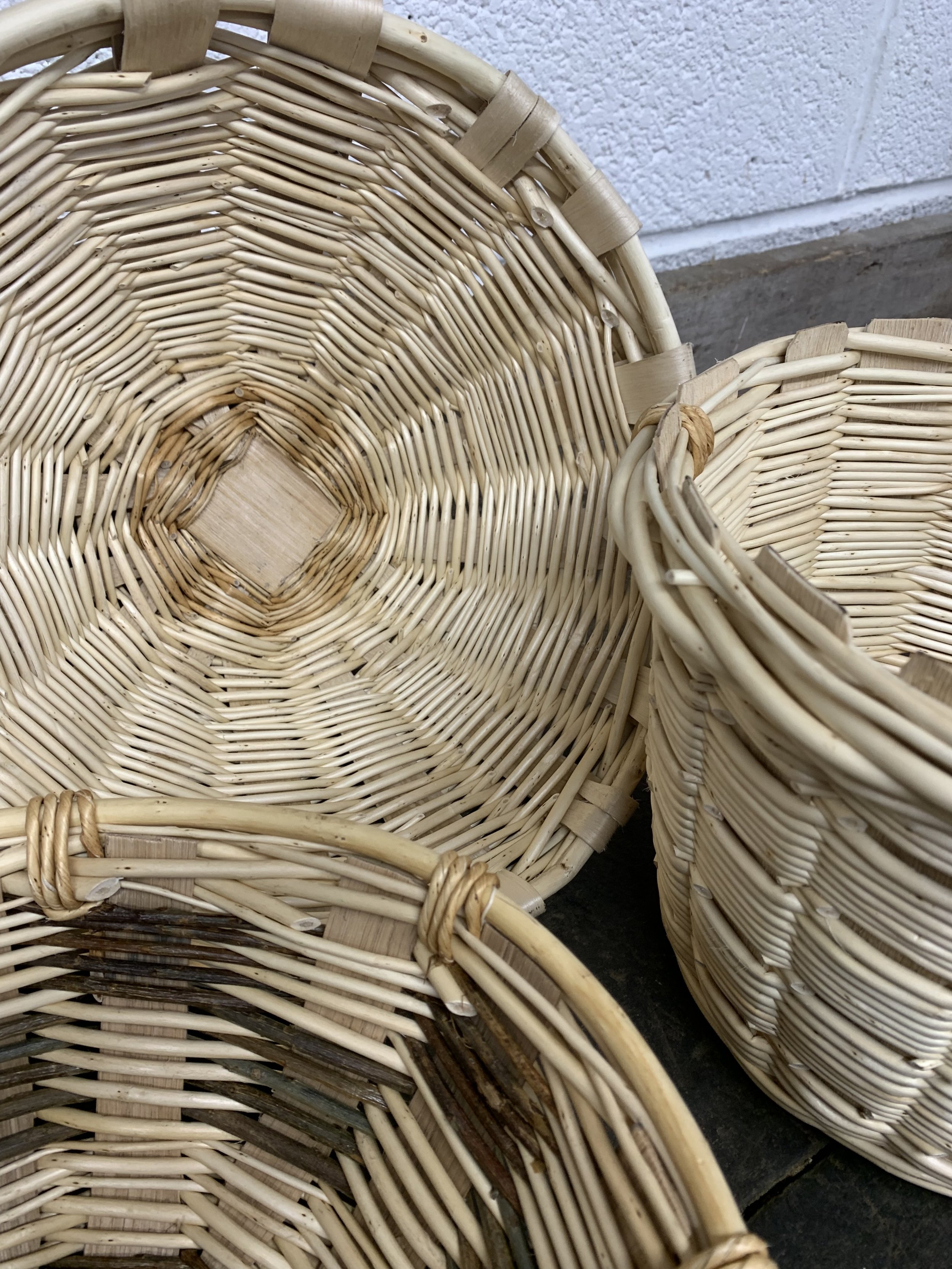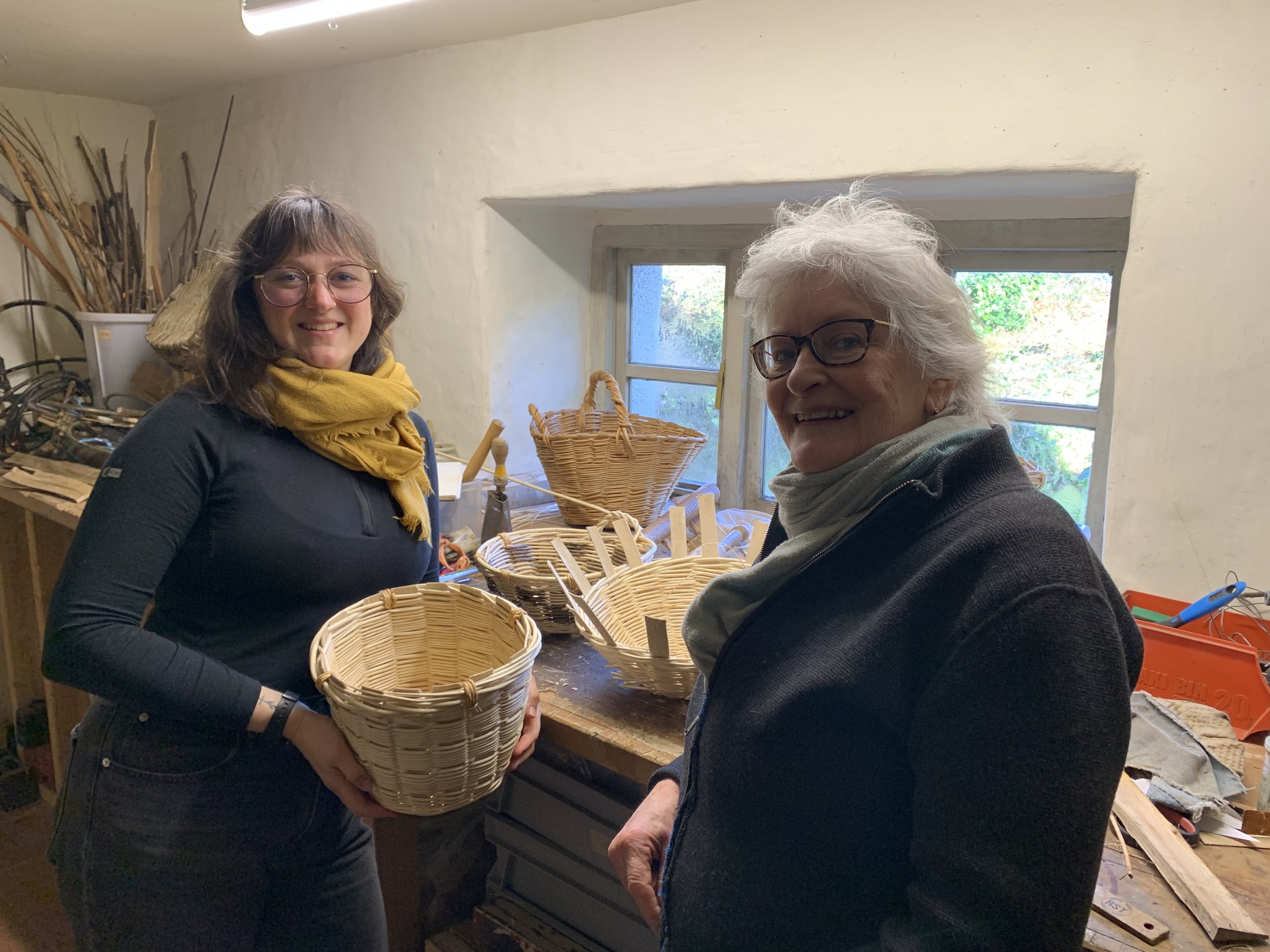I scuttled away to Devon for a day (or three)
Scuttle Work - “Tight weaving of white willow rods on a skeleton made of flat wooden strips riven from green ash logs (in France the wood was often oak, in Germany, willow.)”
(All of the quotes used in this article are from Maurice Bichard’s book ‘Baskets in Europe’)
I travelled down to Devon in search of some very specific knowledge, on how to make to a very specific basket. Scuttle work baskets. A “difficult and particularly onerous” basket to make, in fact. Why? Why did I decide I wanted to learn such a technique? Well, a passion for weaving, for history, for wood, for nuance, and a passion for keeping endangered skills alive.
Great thanks to the Basketmaker’s Association for awarding me the ‘Christiane Sand professional development training bursary’ which allowed me two days of training with the wonderful and generous Hilary Burns. Hilary has a passion for scuttle work and was kind enough to welcome me into her home for a few days of learning, chatting about basket making and experimenting. Hilary has done a great deal of research on the subject of scuttle work and shared with me what she knew, but there isn’t much information on these baskets, and few good examples remain.
So on we go, a quest to learn what we can from what we have, and figure out what’s left in between.
(The baskets I made, a re-creation of a feeding basket at MERL (Museum of English Rural Life), an Oat measuring basket, and a dough proving basket.)
Many examples have been recorded, such as large baskets holding 150 litres, “smaller lop-sided ones for shovelling corn or malt into sacks, 50kg coal scuttles carried on the shoulders to load ships, and oval seedlings used for broadcasting seed or fertiliser”. Possibly best known to the basketry nerds amongst us is the winnowing fan, which dates back to Greek and Roman times, used to separate the chaff from the grain. These baskets were brought over to Northern Europe during the first century AD and were mainly produced in Germany, but also in other places (often along the river Rhine). In particular, in the German village of Emsdetten, “it is likely a local guild existed in the 16th Century and survived until 1810”. They clearly took their industry of winnowing fans incredibly seriously, even being granted privileges by the Bishop of Münster “which forbade the local makers from instructing outsiders in the specialised technique.” They even made the sons and daughters of various families marry in order to keep the craft exclusively to a limited number of families! It was said that whole families would be involved in the process, with the women and children doing the ‘lighter work’, apparently it wasn’t viable unless all the family were involved!
How ironic it is that now, a few of us are desperate for this knowledge, with no one to show us! (I feel a trip to Emsdetten is on the horizon, but maybe I’ll have to marry someone in order to learn the secrets…sorry Tom, it’s for the greater good of basketry.)
I have noticed many similarities from the winnowing fan industry to that of the Oak swill baskets in Cumbria. Both were working communally, having many families who worked on them, gathering together to share the labour. Especially in the heavy processing and material prep (which took up a third of their year, in Emsdetten). The winnowing fans also were made of individually named splints, just like the swills, with each component having a specific name and place in the basket.
Up until the 1950s there were still a handful of people making them in Emsdetten. But sadly the farming industrial revolution saw an end to the winnowing fan industry, in 1968. Other scuttle work baskets were being made in other parts of Europe and in the UK, although it doesn't seem like many.
I first saw these baskets a year or so ago in a book and then, since chatting to my basketry pal and mentor Lorna Singleton, who encouraged me to follow my interest in the subject, I started slowly reading and planning when I might have a crack at learning this bizarre technique. Then lo and behold, the almighty Francois Desplanche and Hilary Burns gave a brilliant talk on scuttle work at Tear Up festival in August 2024 and I was hooked. I knew I wanted to learn.
For me, it is the perfect combination of the things I love. Weaving with willow, using traditional weaves and techniques, but also working with split wood; some key skills needed are knowing how to rive, dress and work with splints, in the construction of a basket, and understanding the properties of wood as well as willow. All to create a super solid and attractive basket? Yes please!
I am incredibly grateful to Hilary and the BA for their help and support and I’m very excited for my knowledge and skills to grow and to try and learn all I can about this fascinating and lost basketry technique.
“The combo of wood and white willow is SO nice. Shaping is key. Splint thickness and shape is also key. Hard on the hands. Expected.” - my notes after day one…



